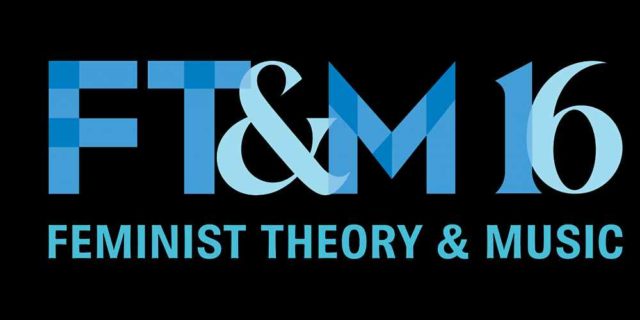Suzanne Cusick, Susan McClary, and Lydia Goehr; to name only a few of my favorite feminist musicologists, theorists, and philosophers. Prior to the pandemic, I was thrilled when I’d suddenly find myself riding in an elevator with Cusick (though I was too shy to introduce myself); I was equally grateful to have given Goehr a ride back to her Columbia University apartment from my own institution; and, while I have not yet met McClary, I can likely quote from her brilliant book, Conventional Wisdom, as I’ve read and re-read it so many times. Needless to say when I saw the call for papers for the Feminist Theory and Music (FT&M) 2022 Conference, I was scared, excited, anxious, and filled with a “why not throw your hat in the ring” attitude. Because I’m not a trained musicologist, nor a theorist, I couldn’t have imagined they’d allow me to present. Long story short: They did!

According to the FT&M’s mission statement, “The study of music from the perspective of feminist theory raises significant questions that transcend the methodologies of any one subdiscipline of music. Feminist Theory and Music (FT&M) has met biennially since 1991 to provide an international, transdisciplinary forum for scholarly thought about music in relation to gender and sexuality, as well as for performances that present such thought in sound and embodied action.”
So, in addition to some amazing thinkers, movers, and shakers within music history, music theory, performance practice, gender studies, philosophy, jazz studies, and cultural anthropology, while at the 30th Anniversary of the Feminist Theory & Music Conference at the University of Guelph (Ontario, Canada), I met musicologist, pianist, and educator Anneli Loepp Thiessen. And I feel privileged to have heard her paper, “B is for Beyoncé: Picture Books as a Tool for Intersectional Music Education.”
As described via the conference website:
Feminist education invites students to investigate their own intersecting identities, and opens conversations around the systems of oppression that have led to women’s erasure from various spheres of society (Vickery and Rodriguez, 2021). For elementary music instructors, feminist education mandates a robust acknowledgement of the diverse contributions of women in music. In what Hess (2015) identifies as a “ground up” approach, this content should not be limited by era, genre, race, or ability and rather should encompass women’s contributions to many facets of music. Bound by male-dominated syllabi, an outdated classical/popular hierarchy, and colonial limitations of merit (Ewell, 2020), many instructors struggle to begin this crucial task.
This presentation demonstrates that picture books are a powerful tool for elementary music lessons by highlighting women’s diverse identities and musical experiences in an immersive way. Tough topics such as racism, homophobia, and sexism are made accessible through stories that invite readers to identify their own positionality and imagine a new future (Swartz, 2020). Visual and literary aids provide a resource that captures the nuances of women’s experiences, beyond what a traditional lesson can offer. Books on figures like Ella Fitzgerald (Kirkfield, 2020), Celia Cruz (Chambers, 2007), and Miriam Makeba (Erskine, 2017) compel students to consider the impacts of racial injustice, industry discrimination, and political turmoil on women’s experiences of music making. This presentation will outline how music picture books can be an effective tool for decolonizing education, promoting equality in music making, and illuminating the profound contributions of women in music.
Her children’s book, The ABCs of Women in Music—with gorgeous illustrations by Haeon Grace Kang—is a treasure trove of great female music makers/generators/thinkers. And each page is filled with endless possibilities for music educators to teach nearly each and every aspect of music. Especially ripe for elementary general music teachers—nay, any music educator—all one needs is a little imagination to help catapult a variety of classroom music lesson plans, classroom creativity, classroom publishing, and more.
Meet Clara the composer, Ella the jazz singer, Selena the pop star, and Xian the conductor!
Women in music are brilliant, creative, brave, and resilient. They are composers, conductors, singers, musicologists, electronic music producers, and so much more … [M]eet 26 remarkable women musicians who collectively span over 1,000 years of music history and represent a diversity of cultures, races, professions, and abilities. Their incredible stories and beautiful work are sure to inspire a new generation of musicians!
I cannot recommend this book enough.